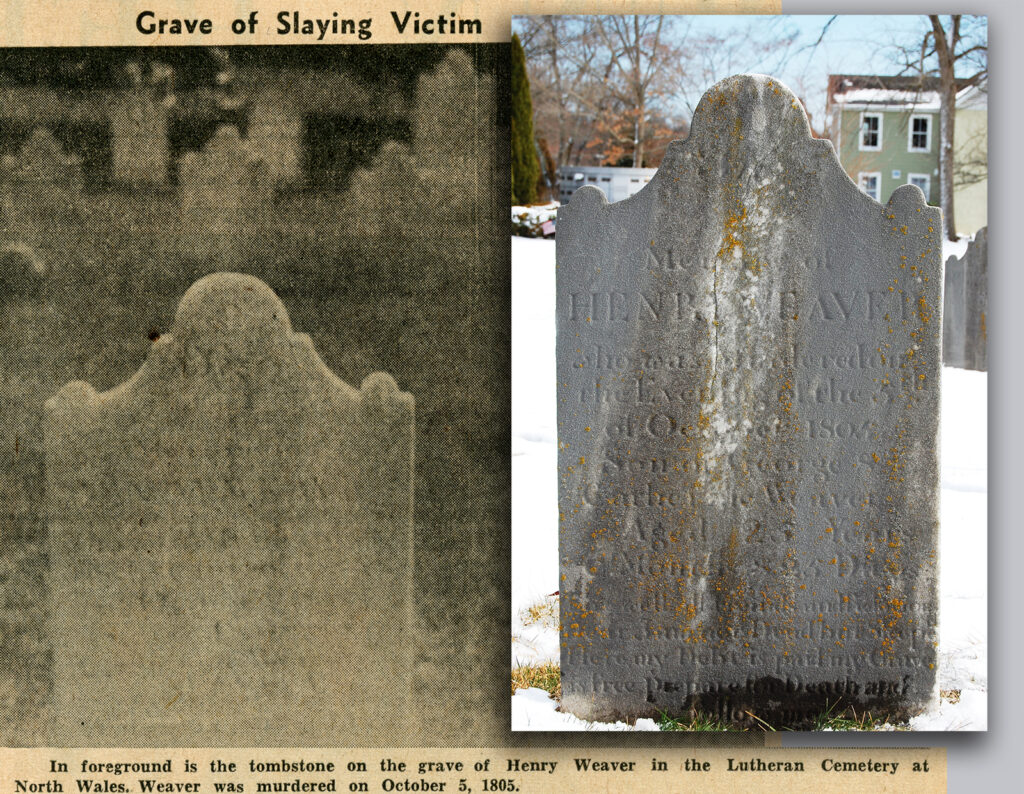We continue with the story of the 1805 murder of Henry Weaver, committed on an isolated stretch of road today known as Dekalb Pike, between Welsh Road and Bethlehem Pike.
Young Weaver was not only an active industrious man, but widely known, having a good character and highly respected. His funeral was attended by multitudes, drawn by the interest which the story of his untimely death had created for miles around. His obsequies were attended by all the pomp of a military burial, as he was a soldier belonging to a volunteer company of Artillerymen and his comrades appeared in uniform marching to the mournful dirge of martial music.

This shocking tragedy occurring in rural Montgomery County produced great commotion, not only in the immediate neighborhood, but at a more remote distance. Search was made in every direction for the hiding place of the murderer. Weaver’s father published a proclamation in the newspapers of those days offering a reward for the detection and conviction of the murderer. The Pennsylvania Correspondent newspaper had been started in Doylestown about a year previous. Here is the advertisement inserted by George Weaver, which appeared in several issues of that paper:
$200 REWARD
A most horrible murder was committed on Saturday evening, the 5th of October [1805], on the body of Henry Weaver, between the hours of seven and eight o’clock between Montgomery Square and North Wales [Gwynedd Friends] meeting house, who expired on the spot. The verdict of the Jury states that he was murdered by some unknown person by the discharge of a gun or pistol loaded with shot which entered his head and the upper part of his body together with a stroke on the left temple. Any person who will apprehend the villain shall, upon conviction, receive the above reward.
George Weaver
Montgomery Square
October 7, 1805
Public opinion soon settled on the belief that the guilty party was no stranger to Weaver. Who had committed the fatal deed was the absorbing question that agitated the minds of men and caused a variety of puzzled conjectures. No one had seen the act committed, and it was only by circumstantial evidence that guilt could be fastened upon anyone. The murder was clearly planned and premeditated.
It soon became evident that robbery was not the motive of the killing, for the victim had no money with him, and no attempt had been made to rob his person or the contents of his wagon, loaded as it was with store goods. In this case it became evident that the deed was committed by some person in the neighborhood who knew Weaver, the circumstances of his going to Philadelphia, and the road by which he would return. Another motive became apparent: to be rid of his person, in order to accomplish a nefarious purpose.
Every effort was made to sift the matter to the bottom. But this was one of the murders that would not “out.” Nor will it ever be legally known — until the day of Judgment — by whose hand the crime was committed. Several persons in the immediate neighborhood were taken into custody on suspicion, but it was impossible to obtain proof sufficient to hold any of them for trial and they were accordingly released. Although the murderer escaped the penalty of the outraged law, he did not evade the searching scrutiny of public suspicion.
Among the persons arrested was a young man, living on the North Wales road, about three quarters of a mile west of Montgomery Square. Neighborhood gossip alleged that an illicit friendship had sprung up between this man and the wife of Weaver. There may have been a wronged husband on this account, but this was not known to have been the case. But in some way the violation of the Seventh Commandment led to the commission of a most fearful crime: a not-unusual result of an unlawful amour.
What afterwards became of the wife of Weaver, we have not learned. The suspected person was later married to another woman and continued to live as a farmer in the neighborhood. Tradition says that many years afterward the suspected slayer of Weaver voluntarily expiated his crime by dying the same death as his victim. The suspected person committed suicide by shooting himself with a pistol.

The father of Henry Weaver was an industrious and thrifty man and reported to be wealthy. He was for many years the owner of the store and tavern, kept at the north corner of the State Road [today called Upper State Road] at its intersection with Bethlehem pike. The Weavers not only owned the tavern but possessed considerable landed property, both east and west of the village. Henry was his eldest son, besides whom he had one child, a son John. But all traces of the family have long since disappeared.
About a half mile southwest from Montgomery Square, a memorial stone was placed by the west side of the State road [Dekalb Pike] to mark the fatal spot where Henry Weaver fell that night so long ago. This stone remained on the roadside until perhaps the 1880s or 1890s. What became of the stone is unknown.
Thus we bring to a close the story of one of Montgomery county’s most baffling murder mysteries.
This post is sourced from a column entitled Early North Wales: Its History and Its People penned by long-time North Wales resident historian Leon T. Lewis. The article appeared in its original form in the June 16, 1959 issue of the North Penn Reporter.
